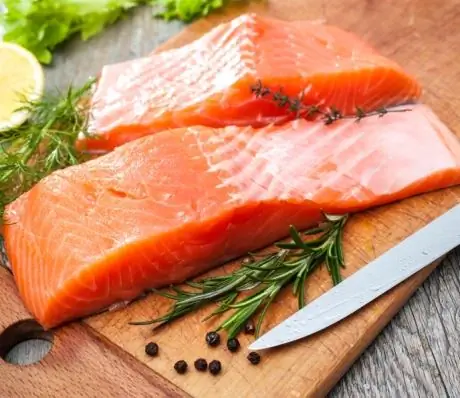- Author Rachel Wainwright [email protected].
- Public 2023-12-15 07:39.
- Last modified 2025-11-02 20:14.
Fish sauce

Fish sauce is a seasoning for the first and second courses of Thai cuisine, which is prepared from salted fish. The popularity of fish sauce in Thailand can only be compared with the spread of soy sauce in China or salt in Europe. It's hard to imagine what the world-renowned Thai cuisine would be like without this seasoning. In addition to Thailand, the sauce was spread in the Philippines, Vietnam, Laos, Cambodia.
In appearance, fish sauce is a reddish-brown liquid, its aroma is pronounced, marine.
Fish sauce recipe
To understand how a sauce can be useful, it is important to know how it is made. For the production of the sauce, the so-called "illiquid" fish is used, which is unsuitable for sale due to its condition or size: usually a fish of 5-15 cm in length is used for the sauce. In this case, a prerequisite is that the fish must be fresh. Thai fishermen pickle the fish for the sauce as soon as they return with their catch. This is the only way to ensure that the sauce is aromatic and tasty.
Initially, freshwater fish was used to make the sauce, but today, when its quantity has significantly decreased, they began to prepare a seasoning from sea fish - most often from anchovies or fish related to them.
So, according to the recipe, fish sauce begins to be prepared as follows: freshly caught, washed, dried, mixed with salt fish is put under a press in large barrels. The fish are kept in this way for 9-12 months. The liquid that is drained from the barrels after a year and filtered is practically fish sauce. In order for the characteristic fishy smell to disappear, the filtered juice of salted fish is poured into clean barrels, keeping it in them for about a month. The resulting product is a first grade sauce. Sauces of the second and third grades are obtained after mixing fish juice with water. At the same time, the low grade sauce is aged for a much shorter time - only 2-3 months.
Why is fish sauce useful?
If we talk about the product of the highest grades, then it contains vitamins from group B, which are responsible for metabolism, visual function, hemoglobin production, the state of blood vessels, skin and microcirculation.
In addition, fish sauce contains proteins, iodine, phosphorus, iron, calcium.
Fish Sauce - Cooking Applications
Traditionally, fish sauce in Thai cuisine is used for frying fish, meat, vegetables. It is added to first courses, seasoned with salads, and other sauces are prepared on its basis.
Let's give some recipes with fish sauce. Try dressing a seafood or vegetable and meat salad with fish sauce mixed with chili and lime juice. This dressing is ideal for steamed sea or river fish.
Pure fish sauce goes well with boiled shrimp, eggplant salad.

Of course, the use of fish sauce of the first or second grade is strongly recommended, since a lower quality product may contain dyes, flavor enhancers, and sugar.
An interesting feature of high-quality fish sauce is that it emphasizes the aromas of the ingredients in the dish, but the sauce itself is almost invisible after cooking.
Contraindications
Fish sauce may not be suitable for those who are allergic to fish, it cannot be used for cooking for those who have shown an individual intolerance to the product.
In order to use a really healthy and savory sauce, you need to be able to choose it.
When choosing a sauce, you should pay attention to its color - it should be, as already mentioned, reddish-brown and, importantly, transparent. If the sauce is cloudy or has impurities in it, then this is a low-grade or stale sauce.
What else is important to know for housewives who decide to master the basics of exotic Thai cuisine: contrary to expectations, fish sauce does not smell like fish. So if your dish starts to smell fishy, change the sauce.
Found a mistake in the text? Select it and press Ctrl + Enter.






